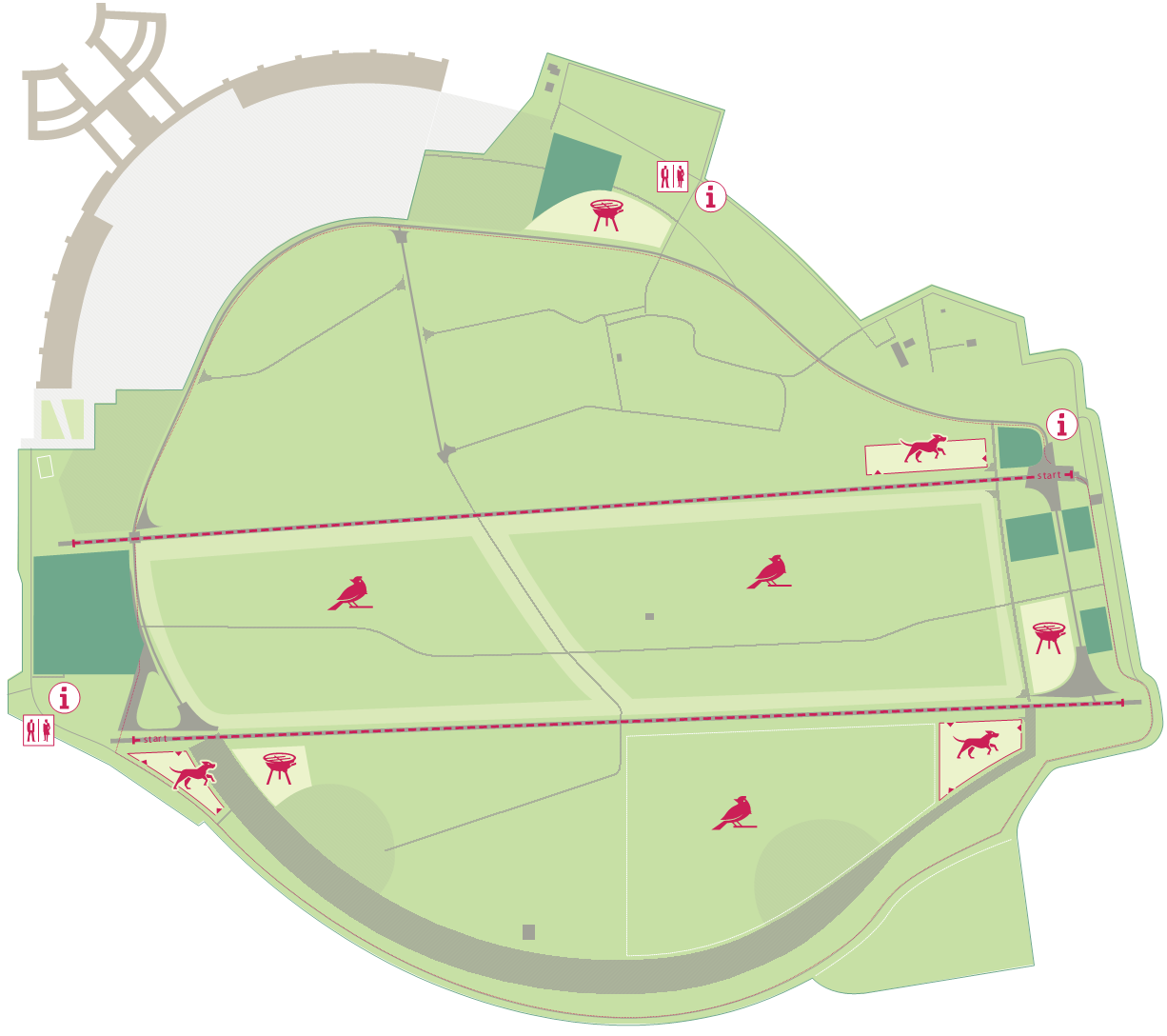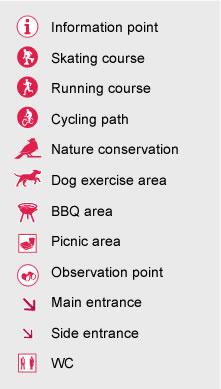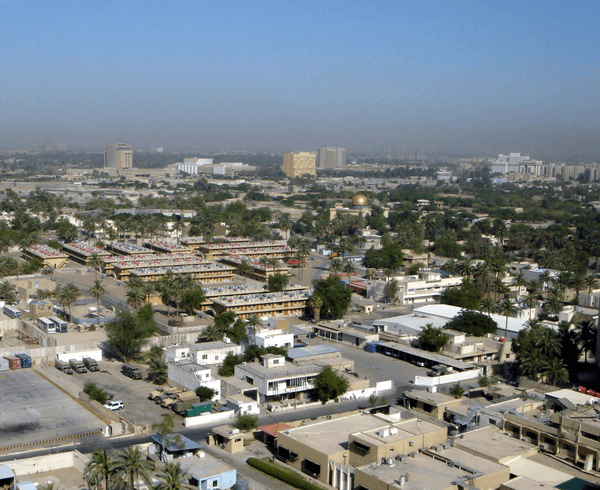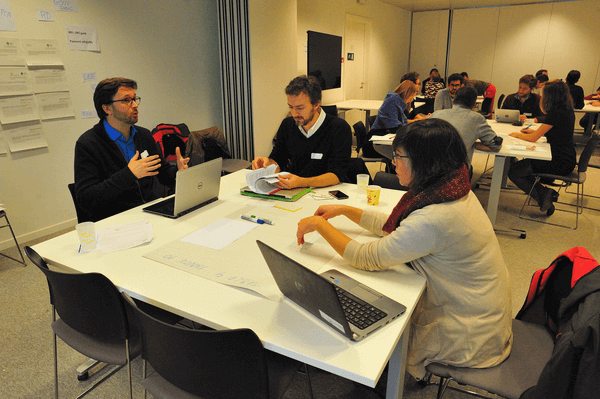 Airfield before opening to public - © Berlin Senatsverwaltung für Stadtentwicklung und Umwelt
Airfield before opening to public - © Berlin Senatsverwaltung für Stadtentwicklung und Umwelt Art miniature golf - a pioneer project - © Berlin Senatsverwaltung für Stadtentwicklung und Umwelt
Art miniature golf - a pioneer project - © Berlin Senatsverwaltung für Stadtentwicklung und Umwelt Map of former airfield - © Berlin Senatsverwaltung für Stadtentwicklung und Umwelt
Map of former airfield - © Berlin Senatsverwaltung für Stadtentwicklung und Umwelt Legend to map of former airfield - © Berlin Senatsverwaltung für Stadtentwicklung und Umwelt
Legend to map of former airfield - © Berlin Senatsverwaltung für Stadtentwicklung und Umwelt Impression of park in summer - © Berlin Senatsverwaltung für Stadtentwicklung und Umwelt
Impression of park in summer - © Berlin Senatsverwaltung für Stadtentwicklung und Umwelt
City
Berlin
Main actors
City Government, Supranational / Intergovernmental Institutions
Project area
Inner City
Duration
2008 - 2014
The project "Tempelhofer Freiheit" ("Liberty of Tempelhof") aims to establish a diverse combination of reuses of the former Berlin Tempelhof airport. With a size of 358 hectares the airfield is considered to be one of the largest innercity open spaces worldwide.
The project "Tempelhofer Freiheit" establishes a diverse combination of reuses for the former Berlin Tempelhof airport. The airfield, 358 hectares, is considered one of the largest inner-city open spaces worldwide. The main challenge is finding an agreeable use for the land due to different interests.
The Government of Berlin owns the site, and promotes citizens' participation through classical and innovative methods. The main building holds events, and the former aerodrome is open as a public park. Sections have been reserved for specific temporary uses like community gardens, educational projects, an initiative to construct a centre for religious dialogues, and seasonal sports.
The park attracts citizens from all walks of life, and the former airport has turned into a space for new ideas. 20 pioneer projects settled on the field, revitalising an area, which was cut off from the city for almost 100 years.
On May 25th 2014 a referendum to decide the future of the Tempelhofer Feld was held. The referendum resulted in a civilian decision for the Tempelhofer Feld to remain in its current state.
Berlin’s concept, applicable in any city with a large number of abandoned sites, can be applied with low financial resources.
Berlin is characterised by the many abandoned sites and buildings such as: industrial wastelands, former military facilities, and the Berlin Wall Death Strip. Tempelhof airport is most likely the most prominent among these famous relics.
The airport of Berlin Tempelhof is strongly connected to the city’s history. In 1923 the old “Berlin Central Airport” was opened for airline traffic. The new airport was built from 1936 to 1940. From 1945 to 1993 it was used by the US Air force including the famous airlifts to West Berlin in 1948. From 1993 on, the airport was opened to civil aviation again. After Germany's reunification, the airport was closed in May 1996 due to its inner-city location. Eventually, air traffic stopped in 2008. The huge area turned into a potentially high value fallow land in the centre of Germany's capital.
The Berlin City Government decided to initiate an incremental development process. The overall objective was to satisfy citizens’ needs on a long term basis, respecting recent and forecast socio-economic circumstances. One main challenge was to include the numerous private and public interests in the eventual plan. It was critical to create diverse possibilities of participation addressing a large and varying population. Planners needed to find a way of not only giving them the chance to take part in planning, but also to initiate developments. After 100 years of being cut out of the city, it was a challenge to find ways of making the airfield attractive to citizens, activating it as a part of the city, and bringing up new qualities of urban development by fulfilling respective overall goals.
Since a top-down development was logistically impossible, and reuses took time in post reunification Berlin to establish, the pioneer projects with temporary contacts became popular. Previously, related reuse initiatives sprung up informally and spontaneously. These projects were recognised for enhancing cultural life and economic potential in formerly stagnant zones. In regards to Tempelhofer Freiheit, temporary usage contracts were given to pioneer projects after a selection procedure. This concept was professionalized and became a formal measure of reanimating open spaces.
Moreover, continuous population growth in Berlin (+40,000 in 2011) is a factor for rising rents and housing shortages in the city. An estimated number of 10,000 new dwelling units have to be built every year in order to meet the demand and to avoid rents increasing. 4,500 new dwelling units are built in average every year in Berlin. The Senate Department for Urban Development and Environment developed a Masterplan for the construction of 4,700 new dwelling units (at a lower / middle level of rents) at the edge of the field. This Masterplan also foresaw the construction of the new Regional Library for € 270 million.
In October 2008 the airport was closed to air traffic, and since September 2009 Berlin owns the field and buildings. The Senate Department for Urban Development and Environment is responsible for the coordination of Tempelhofer Freiheit. Many different divisions contribute actively to the planning. In December 2010, the state-owned limited liability company Tempelhof Projekt GmbH was founded to integrally develop the reuse of the former airport. Its main responsibilities include strategic planning, the creation of suitable building-laws and infrastructure, and preparation of building sites for a wide range of different investors and investor groups. The establishment and management of the park landscape were undertaken by Grün Berlin GmbH, another limited liability company.
Initiatives began in May 2007 through an internet dialogue. Immense public interest was confirmed by 400 submitted ideas of development, 1,600 comments, and 9,800 ratings. At the same time an intensive media campaign was started to promote this new urban space to the public. In summer 2009 6,000 questionnaires were sent to residents living near the field and 1,000 to other parts of Berlin, to identify citizens' needs. At 25 - 30 %, the response rate was very high. In addition, in-depth talks were held with 17 focus groups. In October 2009 a citizens' participation event attended by 4,500 citizens took place in one of the hangers. The results of these investigations were fundamental for a landscape planning competition which started in March 2010. 78 proposals were submitted, 40 % from outside Germany. In June 2010 the jury selected six teams to further develop their ideas. In August, a public participation weekend took place with 2,400 citizens, along with the jury and representatives of the city administration, to exchange ideas about the next stage of competition.
Aside from these rather conventional methods of participation, citizens were encouraged to contribute ideas in a more direct way. As early as May 2010 the field of the airport was opened as a public park, with restricted daily opening times. Bicycles and non-motor vehicles are allowed in the park, and areas e.g. for barbeques or model aircrafts have also been dedicated. Other parts of the park are reserved for natural protection. Since its opening, the behaviour of citizens on the field and their proposals for improvement have been rigorously documented. In 2013 an advisory board of users will be developed for the park, in which e.g. members of children and senior groups, disability associations, neighbourhood associations, sport clubs, and pioneer users gather.
Another main strategy of reviving the fallow land was to open areas for a range of temporary uses. To begin the process, three pioneer-fields have been selected. Activities on the new urban terrain are meant to be economically self-sustainable and encourage the use of existing resources. Since May 2010, anyone has been able to submit ideas through the online form. Leaflets, a website, and info-points on the field inform those interested on requirements and procedures for recommending a project. Selected projects should fulfil the criteria of sustainability and go along with at least one of the main topics chosen for the development: (“knowledge and learning", "clean future technologies", "sports, health, and wellness", "integration of neighbourhoods", "inter-religious dialogue," and "stage of innovations").
Projects are approved in two stages: first, a commission of local and external experts, representatives of the Berlin Senate, and districts consult the developers in selecting generally qualified projects. Second, political boards choose projects for discussions in preparation of a contract. The right of temporary use is given for at least one year and can be extended up to three years depending on location, investments, and progress. Ideally, pioneer projects will have the chance to be integrated in the upcoming uses.
Active citizen participation is another major objective of Tempelhofer Freiheit: A procedure of participation was developed with a master plan, and will be implemented during the on-going planning process. Conferences and workshops inform citizens about recent developments, urban contestations are accompanied by citizens' surveys, and didactic exhibitions support the formal measures of participation.
The citizens' initiative "100% Tempelhofer Feld" was opposed to the Masterplan developed by the Senate, and defended the status quo (no building) for the field.
On May 25th 2014 a referendum to decide the future of the Tempelhofer Feld was held. The referendum resulted in a civilian decision for the Tempelhofer Feld to remain in its current state. 64% of the citizens who were participating to the referendum voted in favor of the counter-plan proposed by the citizens' initiative „100% Tempelhofer Feld“. This plan advocated no development, no sale and permanent public accessibility for the whole field. The result of this referendum has a binding effect for the city; it can still be amended by a vote of the Berlin Parliament.
The project Tempelhofer Freiheit is mainly financed by the Land Government of Berlin, which also funds the state owned companies, Tempelhof Projekt and Grün Berlin, who are primarily responsible for the coordination of the processes. Elements of participatory process and management of pioneer uses are also included. Depending on the type, some projects receive additional funding and agreements with private partner.
In general, pioneer projects are characterised by the investment of high personal commitment and relatively low financial resources. Clustered temporary initiatives are encouraged to cooperate and support each other. The projects pay 1,- €/m² per year, and commercial use may result in commission. The pioneer users cover all operation costs themselves.
Since the closure of the airport, there has been a strong interest in possible reuses. Many citizens participated in different types of events, meetings and surveys between 2007 and 2012.
There was an enthusiastic reaction to the opening of the airfield as a public park. A large number of citizens visit the park daily. The inner-city location of the airpark is appreciated for its uniqueness. During the year different types of activities occur: e.g. biking, jogging, barbeques or open air parties in summer, and cross country skiing in winter.
Out of more than 200 projects, which applied in the first and second procedure (another four take place in the next years), by now 22 very different urban pioneers could be established on the former airport field and contribute in upgrading and enriching the open space. Three urban gardening initiatives can be found in the park. One of them offers a very special concept in that each gardener agreed on installing a creatively designed seating area for the use of visitors. As a result, open communication is encouraged in a unique environment of beds of flowers and vegetables. Other examples are miniature golf course, a pavilion for shaolin and Buddhist culture, an open air centre connecting science and society, a uni-cycle school, a "green classroom" for environmental education, and a Gecekondu-Installation in which children can build huts from wood and recycled materials.
Economic damages following the referendum's outcome are estimated by the Senate at € 298 million by 2060 (rising rents, housing shortages, job losses). Investors forecast 30-50% rent increase in the immediate vicinity in the next four years after the referendum.
The opening of the park encouraged an enormous increase in value of surrounding areas. The resulting gentrification puts pressure on less affluent elements of the existing local population, which is hard to regulate. Pioneer users make the connection between old and upcoming neighbourhoods - therefore a major selection criteria is the ability of a project to integrate in the neighbourhood.
The temporary character makes pioneer projects less secure for larger investments. Problems could arise, because the projects may have to leave shortly after being established. Berlin’s experiences show that citizens identify strongly with the small scale structure of temporary initiatives, especially when they are directly involved, e.g. urban gardening initiatives. Citizens formed an initiative to campaign for the aerodrome to remain as a park with temporary uses.
Lack of infrastructure became a handicap for many pioneer projects. Project coordinators are now developing a Mobiles Nano Smart Grid for flexible electricity support. Pioneers also have to follow related rules: e.g. no events at night, cars are not allowed (except for deliveries), there are no fences around the projects etc.. In many cases projects have to make large changes in the budget and start the real work once they are selected. A consulting-network is being developed to encourage self-help. To reduce bureaucratic burdens for projects, different codes of practice including typically needed forms, a handbook on temporary constructions, ways of funding etc. are available.
Special circumstances of the particular place have to be appreciated. In this case the wide open landscape of the airport has a special quality for citizens.
Opening the abandoned airfield as a park was possible because the right circumstances had been created. It was necessary to establish clear rules balancing freedom and necessary regulations. The park is closed at night to avoid squatting and vandalism.
It makes sense to combine new concepts with classical instruments of participation in order to reach a large diversity of citizens. The experiences of Tempelhofer Freiheit show how the initiation of pioneer projects can be supported by municipalities. In this way, alternative profound instrument of citizens’ participation develops and existing physical recourses as well as social capital are used. The approach starts with the people by granting them the freedom to create and initiate. Through incremental planning, observation, and support, the connection between formal planning and informal developments can be made.
The pioneer process is constantly being evaluated and results are used for future improvement. An important lesson learned regarding pioneer users is that planners have to be able to respect a large diversity of small scale users. Supporting initiatives as partners means keeping the process as transparent as possible. The coordination can be complex and only accomplished by qualified professionals. For municipalities, there is the option to source out parts of the process. Universities or similar parties can for example initiate impulse-projects. Another recommendation is to give projects time and freedom to develop and allow innovation. Concepts of Tempelhofer Freiheit can be easily applied in other cities to find new uses for empty areas. A creative and engaged civil society supports a bottom up, top-down combination.
- Amt für Statistik Berlin-Brandenburg (2012): Pressemitteilung. Anhaltende Bevölkerungszunahme in Berlin 2012. Potsdam: Amt für Statistik Berlin-Brandenburg. (GERMAN)
- Senate of Berlin (2012): Berlin.de. The official town portal. Web: http://www.berlin.de/en/ (20.12.2012)
- Tempelhof Projekt GmbH (2010): Zwischen- und Pioniernutzer der Tempelhofer Freiheit. Auf: http://www.tempelhoferfreiheit.de/fileadmin/user_upload/Mitgestalten/Pioniere_der_Tempelhofer_Freiheit_Broschuere_Stand_Dezember_2010.pdf (18.12.2012)
- Tempelhof Projekt GmbH (2011): Tempelhofer Freiheit. Planning the park landsscape. Auf: http://www.stadtentwicklung.berlin.de/planen/tempelhof/de/download/index.shtml (18.12.2012)
- Tempelhof Projekt GmbH (2012a): Tempelhofer Freiheit. Freiraum für die Stadt von morgen. Auf: http://www.tempelhoferfreiheit.de/ueber-die-tempelhofer-freiheit/aktuelles/nachrichten/standortkonferenz/ (21.12.2012) (GERMAN)
- Tempelhof Projekt GmbH (2012b): Übersicht Pioniere. Auf: http://www.tempelhoferfreiheit.de/mitgestalten/pionierprojekte/ (21.12.2012) (GERMAN)
- Tempelhof Projekt GmbH (2012c): Park landscape development. Free space for the city of tomorrow. Auf: http://www.stadtentwicklung.berlin.de/planen/tempelhof/de/download/index.shtml (21.12.2012)
- Tempelhof Projekt GmbH (2012d): Tempelhofer Parkland. The concept. Auf: http://www.stadtentwicklung.berlin.de/planen/tempelhof/de/download/index.shtml (18.12.2012)
- Wohnungsnot in Berlin: Volksentscheid mit unerwünschten Nebenwirkungen, Spiegel Online (11.09.15): http://www.spiegel.de/wirtschaft/soziales/berlin-bauverbot-auf-tempelhofer-feld-verschaerft-wohnungsnot-a-971820.html
- Berliner stimmen im Volksentscheid gegen Bebauung, Zeit Online (11.09.15):http://www.zeit.de/gesellschaft/zeitgeschehen/2014-05/volksentscheid-tempelhofer-feld-ergebnis
- Was Sie über Tempelhof wissen müssen, Zeit Online (11.09.15): http://www.zeit.de/gesellschaft/zeitgeschehen/2014-05/tempelhofer-feld-volksentscheid-faq
- Wie es jetzt auf dem Tempelhofer Feld weitergeht, Berliner Morgenpost (11.09.15): http://www.morgenpost.de/berlin/article128441108/Wie-es-jetzt-auf-dem-Tempelhofer-Feld-weitergeht.html
On Map
The Map will be displayed after accepting cookie policy


